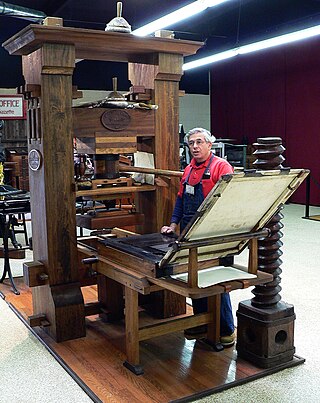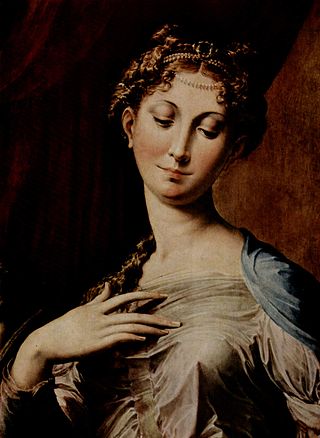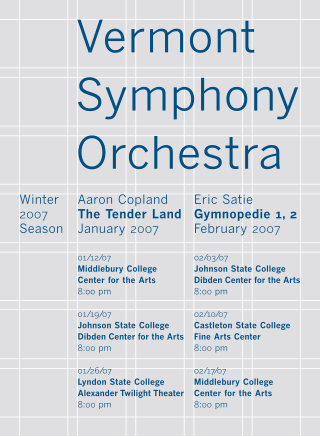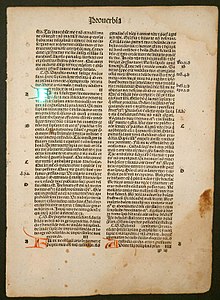
In mathematics, two quantities are in the golden ratio if their ratio is the same as the ratio of their sum to the larger of the two quantities. Expressed algebraically, for quantities and with ,

A printing press is a mechanical device for applying pressure to an inked surface resting upon a print medium, thereby transferring the ink. It marked a dramatic improvement on earlier printing methods in which the cloth, paper, or other medium was brushed or rubbed repeatedly to achieve the transfer of ink and accelerated the process. Typically used for texts, the invention and global spread of the printing press was one of the most influential events in the second millennium.

Typography is the art and technique of arranging type to make written language legible, readable and appealing when displayed. The arrangement of type involves selecting typefaces, point sizes, line lengths, line-spacing (leading), and letter-spacing (tracking), as well as adjusting the space between pairs of letters (kerning). The term typography is also applied to the style, arrangement, and appearance of the letters, numbers, and symbols created by the process. Type design is a closely related craft, sometimes considered part of typography; most typographers do not design typefaces, and some type designers do not consider themselves typographers. Typography also may be used as an ornamental and decorative device, unrelated to the communication of information.
In typography, a serif is a small line or stroke regularly attached to the end of a larger stroke in a letter or symbol within a particular font or family of fonts. A typeface or "font family" making use of serifs is called a serif typeface, and a typeface that does not include them is sans-serif. Some typography sources refer to sans-serif typefaces as "grotesque" or "Gothic", and serif typefaces as "roman".

Jan Tschichold was a German calligrapher, typographer and book designer. He played a significant role in the development of graphic design in the 20th century – first, by developing and promoting principles of typographic modernism, and subsequently idealizing conservative typographic structures. His direction of the visual identity of Penguin Books in the decade following World War II served as a model for the burgeoning design practice of planning corporate identity programs. He also designed the typeface Sabon.

In geometry, a golden rectangle is a rectangle whose side lengths are in the golden ratio, , which is , where is approximately 1.618.

Mathematics and architecture are related, since, as with other arts, architects use mathematics for several reasons. Apart from the mathematics needed when engineering buildings, architects use geometry: to define the spatial form of a building; from the Pythagoreans of the sixth century BC onwards, to create forms considered harmonious, and thus to lay out buildings and their surroundings according to mathematical, aesthetic and sometimes religious principles; to decorate buildings with mathematical objects such as tessellations; and to meet environmental goals, such as to minimise wind speeds around the bases of tall buildings.

Body proportions is the study of artistic anatomy, which attempts to explore the relation of the elements of the human body to each other and to the whole. These ratios are used in depictions of the human figure and may become part of an artistic canon of body proportion within a culture. Academic art of the nineteenth century demanded close adherence to these reference metrics and some artists in the early twentieth century rejected those constraints and consciously mutated them.

In graphic design, a grid is a structure made up of a series of intersecting straight or curved lines used to structure content. The grid serves as an armature or framework on which a designer can organize graphic elements in a rational, easy-to-absorb manner. A grid can be used to organize graphic elements in relation to a page, in relation to other graphic elements on the page, or relation to other parts of the same graphic element or shape.

Book design is the art of incorporating the content, style, format, design, and sequence of the various components and elements of a book into a coherent unit. In the words of renowned typographer Jan Tschichold (1902–1974), book design, "though largely forgotten today, [relies upon] methods and rules upon which it is impossible to improve, [and which] have been developed over centuries. To produce perfect books, these rules have to be brought back to life and applied". Richard Hendel describes book design as "an arcane subject", and refers to the need for a context to understand what that means.
In typesetting and page layout, alignment or range is the setting of text flow or image placement relative to a page, column (measure), table cell, or tab.
Raúl Mario Rosarivo was an Argentine typographer, researcher, designer, poet, painter, and illustrator, known for his work in the analysis of the Gutenberg Bibles. He held the position of General Director of the Buenos Aires Provincial Graphic Workshops.

In typography, a margin is the area between the main content of a page and the page edges. The margin helps to define where a line of text begins and ends. When a page is justified the text is spread out to be flush with the left and right margins. When two pages of content are combined next to each other, the space between the two pages is known as the gutter. The top and bottom margins of a page are also called "head" and "foot", respectively. The term "margin" can also be used to describe the edge of internal content, such as the right or left edge of a column of text.

Divina proportione, later also called De divina proportione is a book on mathematics written by Luca Pacioli and illustrated by Leonardo da Vinci, completed by February 9th, 1498 in Milan and first printed in 1509. Its subject was mathematical proportions and their applications to geometry, to visual art through perspective, and to architecture. The clarity of the written material and Leonardo's excellent diagrams helped the book to achieve an impact beyond mathematical circles, popularizing contemporary geometric concepts and images.

An artistic canon of body proportions, in the sphere of visual arts, is a formally codified set of criteria deemed mandatory for a particular artistic style of figurative art. The word canon was first used for this type of rule in Classical Greece, where it set a reference standard for body proportions, so as to produce a harmoniously formed figure appropriate to depict gods or kings. Other art styles have similar rules that apply particularly to the representation of royal or divine personalities.

Mathematics and art are related in a variety of ways. Mathematics has itself been described as an art motivated by beauty. Mathematics can be discerned in arts such as music, dance, painting, architecture, sculpture, and textiles. This article focuses, however, on mathematics in the visual arts.

A fleuron (;), also known as printers' flower, is a typographic element, or glyph, used either as a punctuation mark or as an ornament for typographic compositions. Fleurons are stylized forms of flowers or leaves; the term derives from the Old French: floron ("flower"). Robert Bringhurst in The Elements of Typographic Style calls the forms "horticultural dingbats". A commonly-encountered fleuron is the ❦, the floral heart or hedera. It is also known as an aldus leaf.
Penguin Composition Rules were the guidelines written by typographer Jan Tschichold for use in composing the pages and typography of Penguin Books. The rules were embodied in a four-page booklet of typographic instructions for editors and compositors. The booklet includes headings for various aspects of composition: Text Composition; Indenting of Paragraphs; Punctuation Marks and Spelling; Capitals, Small Capitals, and Italics; References and Footnotes; Folios; The Printing of Plays; The Printing of Poetry; Make-up.


















